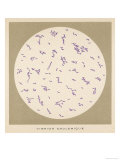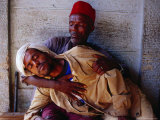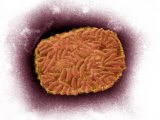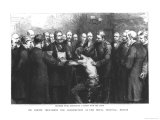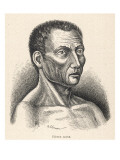|
|
|
Bubonic plague is one of three types of infections caused by the bacterium Yersinia pestis (aka Pasteurella pestis), carried by fleas associated with the black rat and other rodents.
Without treatment, the bubonic plague kills about two out of three infected humans within 4 days; it is generally thought to be the same as the Black Death that swept through Europe in the 14th century and killed an estimated 75-100 million people, or 30-60% of the European population.
Other pandemics of bubonic plague have ravaged the world - the Plague of Justinian (588 AD) estimated 100 million people and caused Europe's population to drop by 50%; the Great Plague of Vienna (1679-1680s) estimated 76,000 deaths.
Alexandre Yersin discovered the bacillus during an 1894 outbreak of bubonic plague in Hong Kong.
FYI ~ The word bubonic is from the Greek word bubo, meaning “swollen gland”. Fleas can also spread septicemic plague that affects the blood vessels, and pneunomic plague in the lungs.
|
|
|
|
The main symptoms of cholera, profuse watery diarrhea and vomiting, are from an infection of the small intestine that is caused by the bacterium Vibrio cholerae. Cholera is trasmitted primarily through consuming contaminated drinking water or food.
Cholera has been present since ancient times, most likely originating in the Ganges Delta. What was confined as a local disease through most of history was spread by trade routes to Russia, then to Western Europe, and eventually to North America.
In 1854 physician John Snow identified the importance of contaminated water in cholera's cause and in 1880s Robert Koch identified V. cholerae with a microscope as the bacillus causing the disease.
Notable people who have suffered or died from cholera are Tchaikovsky, French king Charles X, President James K. Polk, opera singer Angelica Catalani and Henriette Sontag.
|
|
|
|
Diphtheria, first mentioned in the sixth century by Aëtius Amidenus, is a highly contagious upper respiratory tract illness characterized by sore throat, low fever, problems swallowing.
A dreaded disease, diphtheria is virtually eliminated today, however it is still a killer in developing countries and vaccination (DPT (Diphtheria–Pertussis–Tetanus) is recommended for children, and adult booster shots.
Dr. Emil von Behring was awarded the first Nobel Prize in Medicine for his work in developing a serum and the Iditarod Dogsled Race commemorates the the 1925 effort to get the diphtheria serum to Nome, Alaska, preventing an epidemic (also see the animated/live action movie Balto).
|
|
|
|
Malaria, for which there is evidence that it has been with humanity for 50,000 years, is a common, widespread vector-borne infectious disease is transmitted by female Anopheles mosquitos. The symptoms, anemia, fever, and chills, are experienced by 515 million people annually, and responsible for killing between 1 and 3 million people a year, mostly in Africa.
Among the notable people who have suffered or died from malaria (or have thought to) are Alexander the Great, Genghis Khan, Dante, Amerigo Vespucci, Caravaggio, Oliver Cromwell, Lord Byron, Oliver Hazard Perry, George Washington, James Monroe, Andrew Jackson, Abraham Lincoln, Jefferson Davis, U.S. Grant, James & Lucretia Garfield, Theodore Roosevelt, John F. Kennedy, Christopher Columbus, Sir Arthur Conan Doyle, Meriwether Lewis, both Stanley & Livingstone, Osceola, Jesse James, Mahatma Gandhi, Louis Gottschalk, Hemingway, Mother Teresa, Jane Goodall, Roberto Clemente, Davy Crockett, Teilhard de Chardin. [source]
The word malaria is from the Italian - “mal” (bad) + “aria” (air), it is also known as ague and marsh fever, as it was associated with swampy areas that were prime breeding grounds for mosquitos.
|
|
|
|
Smallpox, an infectious disease unique to humans, is believed to have emerged in human populations about 10,000 BC.; in 1979 the World Health Organization (WHO) certified the eradication of smallpox.
Smallpox was a leading cause of death, killing an estimated 400,000 in Europe during the 18th century. Notable victims of smallpox included George Washington, Andrew Jackson, and Abraham Lincoln; Queen Elizabeth I, Jonathan Edwards, Joseph Stalin, Ramses V, Chief Sitting Bull.
|
|
|
|
Tuberculosis is a common and deadly infectious disease most commonly attacking the lungs but can also affect the central nervous, lymphatic, circulatory, genitourinary systems; bones, joints and skin.
In the past, tuberculosis was called consumption, as it seemed to consume people from within, with a bloody cough, fever, pallor, and long relentless wasting.
Over one-third of the world's population has been exposed to the TB bacterium, and new infections occur at a rate of one per second. In addition, a rising number of people in the developed world are contracting tuberculosis because their immune systems are compromised by immunosuppressive drugs, substance abuse, or HIV/AIDS.
Dr. Robert Koch, considered one of the founders of microbiology for isolating the Bacillus anthracis (1877), the tuberculosis bacillus (1882) and the cholera vibrio (1883), and for his development of criteria designed to establish a causal relationship between a microbe and a disease, known as Koch's postulates:
1. The microorganism must be found in abundance in all organisms suffering from the disease, but not in healthy organisms.
2. The microorganism must be isolated from a diseased organism and grown in pure culture.
3. The cultured microorganism should cause disease when introduced into a healthy organism.
4. The microorganism must be reisolated from the inoculated, diseased experimental host and identified as being identical to the original specific causative agent.
World Tuberculosis Day falls on March 24th of each year, the day Dr. Koch announced his discovery of the bacillus responsible for TB (1882).
Among the notable people who have suffered or died from tuberculosis (or have thought to):
Jane Austen, Honoré de Balzac, Frederic Auguste Bartholdi, Marie Bashkirtseff, Aubrey Beardsley, Simon Bolivar, Anne & Emily Bronte, Elizabeth Barrett Browning, Robert Burns, John Calvin, Albert Camus, Frederic Chopin, Anders Celsius, Anton Chekhov, Charlie Christian, Stephen Crane, Martin Delany, Paul Laurence Dunbar, Stephen Foster, George Herbert, Samuel Johnson, Immanuel Kant, John Keats, Sidney Lanier, D. H. Lawrence, Vivien Leigh, Dmitri Mendeleev, James Monroe, Mabel Normand, George Orwell, Pocahontas, Alexander Pope, Henry Purcell, Rachel, Eleanor Roosevelt, John Ruskin, Margaret Sanger, Erwin Schrodinger, Dred Scott, Shanawdithit, Henry David Thoreau, Voltaire, David Walker, Carl Maria von Weber, Thomas Wolfe.
• Thomas Mann describes the progress of the disease in the novel The Magic Mountain.
• “The man of understanding can no more sit quiet and resigned while his country lets literature decay than a good doctor could sit quiet and contented while some ignorant child was infecting itself with tuberculosis under the impression that it was merely eating jam tarts.” ~ Ezra Pound, ABC of Reading, 1934
|
|
|
|
Typhoid fever is transmitted by consuming food or water contaminated with the bacterium Salmonella enterica, serovar Typhi.
Typhoid is a human disease and is spread where good hygiene is not practiced and/or public sanitation has failed (i.e. flooding). Strict hand-washing, careful food preparation, and chlorinating drinking water has led to dramatic decreases in the transmission of typhoid fever in the U.S. Two vaccines are currently recommended by the World Health Organization for the prevention of typhoid.
Typhoid played a critical role in Greek history - historian Thucydides contracted the disease but survived to describe a plague that killed one third of the population of Athens, including their leader Pericles.
Other notable victims (*died) of typhoid were Abigail Adams*, Jane Austen, Prince Albert* (husband of Victoria), Mormon founder Joseph Smith, Tadeusz Kosciuszko, Louisa May Alcott, Charles Darwin, Willie Lincoln*, Wilbur Wright*, Gerard Manley Hopkins*, Franz Schubert*, Roger Sherman*, Mary Kingsley*, Georgia O'Keeffe, Ravi Shankar.
Typhoid Mary is the public name for Mary Mallon, a cook who appeared healthy but carried the bacterium - she managed to spread the disease to 53 people, three died. She spent the last three decades of her life in quarartine.
|
|
|
|
Typhus is any of several similar diseases caused by an organism, Rickettsiae, classified between a true bacteria and viruses.
|
|
|
|
Yellow fever, an acute viral hemorrhagic disease, currently causes 200,000 illnesses and 30,000 deaths every year in unvaccinated populations in tropican and subtropical areas of the Americas and Africa.
Most cases of yellow fever are relatively mild with fever, headache, chills, back pain, loss of appetite, nausea and vomiting, that begin after a three to six day incubation. Severe cases involve liver damage that produces jaundice (a yellowing of the skin), and an increased tendency to bleed.
Yellow fever is transmitted by the bite of female mosquito, Aedes aegypti, and several other species. It is thought that yellow fever was brought to the Americas by the slave trade.
An epidemic of yellow fever occured in Philadelphia in 1793, forcing the young United States government administration to flee the city, including George Washington.
Yellow fever also stymied the building of the Panama Canal until Army doctor Walter Reed, working from the idea of Cuban, Dr. Carlos Finlay, recognized that yellow fever was caused by mosquitos and ordered insect control to protect the workers. Nurse Clara Maass was a volunteer in the fight against yellow fever - she was biten twice by a yellow fever infected mosquito; the first bite resulted in a mild case, she died the second time.
Among the notable people who have suffered or died from yellow fever are Benjamin Latrobe, Oliver Hazard Perry, Thomas Nast, Dolley Payne Todd (Dolley Madison), Alexander Hamilton and his wife, and Dr. Benjamin Rush.
|
|
|
|
Understanding the Common Cold
Defines cold and inflammation. Illustrates and discusses the role of the nose, paranasal sinuses, throat and tonsils, ear, and trachea and bronchi.
• endocrine system posters
|
|
|
|
Understanding Alzheimer's
Discusses the aging brain and dementia, providing an overview of Alzheimer's disease. Illustrates affected areas of the brain and the abnormal cellular structures involved with AD: granulovacuolar degeneration, neurofibrillary tangles, and amyloid plaques. Discusses the stages of Alzheimer's disease and shows the physical changes in the brain cortex caused by Alzheimer's. Illustrates and defines the role of neurotransmitters as messengers.
• Alois Alzheimer
FYI - did you know that a medicine developed from daffodils is used in the treatment of Alzheimer's?
|
|
|
|
The Diseases Explained: Bipolar Disorder
Illustrated patient education poster describing bipolar disorder, the causes, recognizing the symptoms, diagnosis, drug treatment and self-care recommendations. Information is written in an easy-to-read level for patients and family members. Ideal for clinic waiting rooms, examination rooms, hospitals, and educational programs.
• nervous system posters
• Sylvia Plath poster
• Virginia Woolf photo
|
|
|
|
Understanding Breast Cancer
Defines breast cancer. Illustrates breast anatomy and the the most common types of breast cancer. Visually and textually describes ways of diagnosing breast cancer including breast self examination, mammography and biopsy. Shows staging of breast cancer and lists causes, sign & symptoms, and treatment options.
• feminine anatomy posters
• Did you know Abigail and John Adams daughter 'Nabby', Juliette Gordon Low, founder of the Girl Scouts, dancer Loie Fuller, mathematician Sophie Germain, and illustrator Kate Greenaway, died of breast cancer?
• January is National Cervical Cancer Awareness Month
|
|
|
|
Understanding Cancer - biology
Introduction to understanding cancer and the microslide subjects covered - with descriptions: Healthy Skin Tissue; Cancerous Skin Tissue; Tumor; Lung Normal/ Lung Cancerous; Melanoma/ Carcinoma; Colon Normal/ Colon Cancerous; Breast Normal/ Breast Cancer; Testes Cancer/ Cervix Cancer
• biology posters
|
|
|
|
Understanding Skin Cancer
Defines skin cancer and provides detailed illustrations of how it develops from sun exposure. Shows and discusses various types of ultraviolet radiation and how each kind penetrates skin layers. Illustrates and shows photos of various types of precancer and cancer. Lists the ABCs of malignant melanoma and provides graph which indicates the rising incidence of skin cancer. Shows how skin naturally works to prevent skin cancer, and illustrates difference between sunscreen and sun block protection.
• sun posters
• skin & sense of touch posters
|
|
|
|
Understanding Carpal Tunnel Syndrome
Defines carpal tunnel syndrome (CTS) and nerve compression syndrome. Shows the carpal tunnel and cross sections of a normal wrist and one with CTS. Causes, risk factors, and symptoms are listed. Management techniques and healthy lifestyle changes are also covered.
• skeletal system posters
|
|
|
|
|
|
|
|
|
|
|
|
|
|
previous page | top | DISEASES & DISORDERS pg 1 | 2 | 3 | 4
|
|
I have searched the web for visual, text, and manipulative curriculum support materials - teaching posters, art prints, maps, charts, calendars, books and educational toys featuring famous people, places and events - to help teachers optimize their valuable time and budget.
Browsing the subject areas at NetPosterWorks.com is a learning experience where educators can plan context rich environments while comparing prices, special discounts, framing options and shipping from educational resources.
Thank you for starting your search for inspirational, motivational, and educational posters and learning materials at NetPosterWorks.com. If you need help please contact us.
|
|
|









